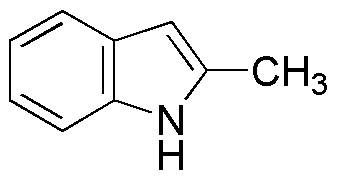2-Methylindole is widely utilized in research focused on:
- Pharmaceutical Development: This compound serves as a building block in the synthesis of various pharmaceuticals, particularly in developing drugs targeting neurological disorders due to its ability to interact with specific receptors in the brain.
- Aromatic Compounds in Organic Synthesis: It is used in organic chemistry as a precursor for synthesizing more complex aromatic compounds, which are essential in creating dyes, fragrances, and agrochemicals.
- Biological Research: Researchers leverage its properties to study biochemical pathways and interactions, especially in cancer research, where it may influence cell signaling pathways.
- Material Science: 2-Methylindole is explored for its potential in developing new materials, including polymers and coatings, due to its unique structural properties that enhance material performance.
- Environmental Applications: It is investigated for its role in the degradation of pollutants, contributing to environmental chemistry studies aimed at developing sustainable methods for waste management.
General Information
Properties
Safety and Regulations
Applications
2-Methylindole is widely utilized in research focused on:
- Pharmaceutical Development: This compound serves as a building block in the synthesis of various pharmaceuticals, particularly in developing drugs targeting neurological disorders due to its ability to interact with specific receptors in the brain.
- Aromatic Compounds in Organic Synthesis: It is used in organic chemistry as a precursor for synthesizing more complex aromatic compounds, which are essential in creating dyes, fragrances, and agrochemicals.
- Biological Research: Researchers leverage its properties to study biochemical pathways and interactions, especially in cancer research, where it may influence cell signaling pathways.
- Material Science: 2-Methylindole is explored for its potential in developing new materials, including polymers and coatings, due to its unique structural properties that enhance material performance.
- Environmental Applications: It is investigated for its role in the degradation of pollutants, contributing to environmental chemistry studies aimed at developing sustainable methods for waste management.
Documents
Safety Data Sheets (SDS)
The SDS provides comprehensive safety information on handling, storage, and disposal of the product.
Product Specification (PS)
The PS provides a comprehensive breakdown of the product’s properties, including chemical composition, physical state, purity, and storage requirements. It also details acceptable quality ranges and the product's intended applications.
Certificates of Analysis (COA)
Search for Certificates of Analysis (COA) by entering the products Lot Number. Lot and Batch Numbers can be found on a product’s label following the words ‘Lot’ or ‘Batch’.
Numéro de catalogue
Numéro de lot/série
Certificates Of Origin (COO)
This COO confirms the country where the product was manufactured, and also details the materials and components used in it and whether it is derived from natural, synthetic, or other specific sources. This certificate may be required for customs, trade, and regulatory compliance.
Numéro de catalogue
Numéro de lot/série
Safety Data Sheets (SDS)
The SDS provides comprehensive safety information on handling, storage, and disposal of the product.
DownloadProduct Specification (PS)
The PS provides a comprehensive breakdown of the product’s properties, including chemical composition, physical state, purity, and storage requirements. It also details acceptable quality ranges and the product's intended applications.
DownloadCertificates of Analysis (COA)
Search for Certificates of Analysis (COA) by entering the products Lot Number. Lot and Batch Numbers can be found on a product’s label following the words ‘Lot’ or ‘Batch’.
Numéro de catalogue
Numéro de lot/série
Certificates Of Origin (COO)
This COO confirms the country where the product was manufactured, and also details the materials and components used in it and whether it is derived from natural, synthetic, or other specific sources. This certificate may be required for customs, trade, and regulatory compliance.


